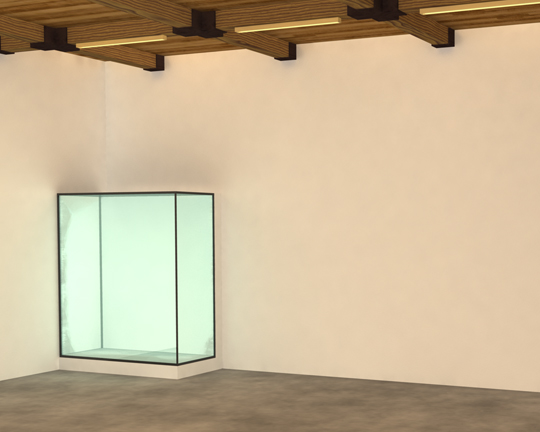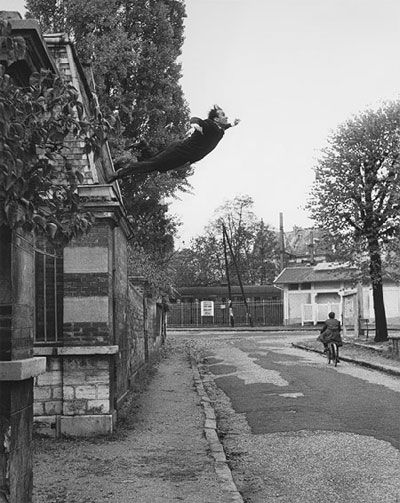
Speaking through one of the mediums, Klein told us that many of his regrets are linked to some of his greatest achievements. As a youth he lay down on the beach and dreamed upwards at the sky, using his finger to trace his signature across it. With that gesture he claimed all of heaven as the scope of his ambitions. He sought to master the realm of the sky and yet, in contrast, would spend years focusing on the martial practice of Judo. He saw Judo as a means of navigating spiritual space by use of the body but, ultimately, its focus on physicality proved a distraction, making the feat of weightlessness impossible. It was only after 1959, when he quit teaching Judo, that he was able to fly independent of machinery or assistance. He felt that this was his greatest spiritual achievement and yet his first thought was toward base publicity and fame. He posed for a photograph taken by his friend Harry Shunk and used it to promote his art practice when his response should have been something much more humble and reflective. The irony is that when he received the great honor of decorating the Gelsenkirchen Opera House, a material and professional triumph, he traveled to Saint Rita Monastery to give offerings. Such was his deeply conflicted nature, to celebrate a spiritual achievement with an act of pride and a material achievement with an act of reflection. He refused to ever fly again for the sake of a camera and even remained silent when, for years afterward, his critics claimed Shunk's photo was a fake or a montage or that various tricks had been employed. All of the other images captured of him in flight were mere happenstance and some, it is possible, were actual fakes.
The installation took place over many months and some of the mediums employed by the gallery began to suffer from stiffness in their joints, particularly in the hands. It is rare for sèances to last so long or to involve so many mediums and it turned out that, by allowing Klein to possess their bodies, some of his anxieties from life lingered on in them. Klein later revealed that while he was alive he had never actually touched his work with his own hands, always using a surrogate's body or else relying on implements such as sponges and rollers. One of the most touching moments during the installation was when the mediums, swathed in the blue robes that aided them in channeling Klein, granted him a final wish. They took turns allowing him to possess them and, one by one, dipped their fingers in International Klein Blue ink to mark a sheet of paper. In life, using his own hand would have tied him to the work too closely. It would make the object an artifact of his body rather than the pure realization of an idea. As a spirit, however, the context had changed, and he was finally to leave behind an imprint of himself.
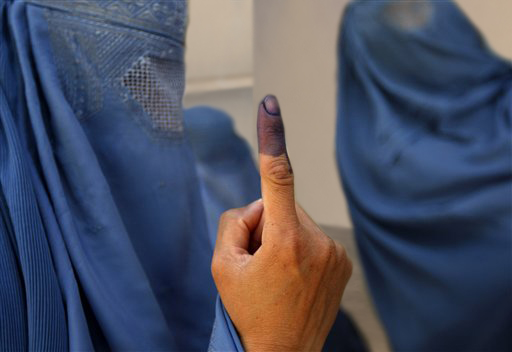
The blue fingerprint represents the power of the individual to act confidently and leave a mark on the world even against the presence of an oppression as great as death.
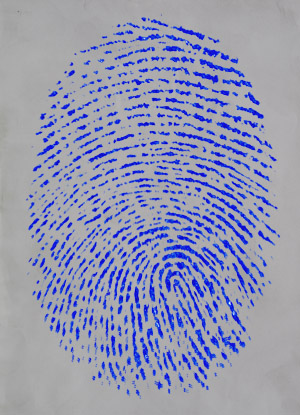
According to another of the mediums it was his own highly trained sensitivity that ultimately cost him his life. It was something that came up after they employed the chromatic invocation. The use of light to embody an essence was a painful reminder of his death. He had suffered his first heart attack while watching a screening of Mondo Cane, a movie that featured one of his performances. The filmmaker had taken many liberties with his portrayal of Klein and had, in the process, distorted the essence of his work. The radiance that he had emitted while performing was twisted and re-emitted as light from the projector. The inversion of his own artistic radiance was too much for one of Klein's extremely sensitive nature and left him with a lingering condition that worsened with time. It was not long before he realized that he would not survive to see the birth of his first child. He could not share the world with one whom he had endowed with so much of his own energy and, tragically, passed away weeks before his child was ever born.
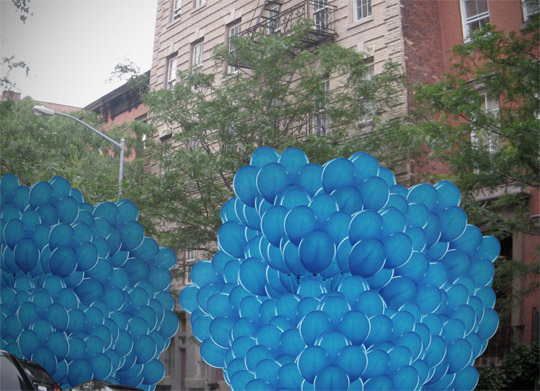
We decided to leave one thousand blue balloons, traditionally released into the wind, to remain tethered to the ground. Just as Klein was never able to have the joyous encounter of meeting his child, so too are the balloons left without their joyous ascent into the sky.
Invokation of Chromatic Materialization Between Vigor and Oblivion
Repeated use of the Invokation can produce a destabilized pictorial sensibility and is not advised
Press Release:
While Yves Klein was alive he devoted much of his time and energy to creating art that defied traditional expectations and mediums. His goal was to create a kind of pure art that existed in the experience of the viewer rather than in the form of a material object or commercial asset. His legacy lives on in the form of video, performance, and conceptual artists working today. Here at the Waymaker Gallery we wanted to present his work in a manner relevant to this contemporary context, feeling that too often retrospectives of his work primarily showcase his material output and reference his ambitious performative works only via dusty photographs trapped behind inch thick glass. We feel that Klein's most remarkable achievement was way that he re-envisioned the very nature of art making. His is not a body of work that can represented through relics, it must be reborn completely or else only serve to perpetuate the antiquated systems of thinking that he challenged while alive.
It is with this goal in mind that we took on the ambitious task of installing "The Specialization of Sensibility in the Raw Material State into Stabilized Pictorial Sensibility, The Void". As he described the project in his own words:
"The object of this endeavor: to create, establish, and present to the public a palpable pictorial state in the limits of a picture gallery. In other words, creation of an ambience, a genuine pictorial climate, and, therefore, an invisible one. This invisible pictorial state within the gallery space should be so present and endowed with autonomous life that it should literally be what has hitherto been regarded as the best overall definition of painting: radiance."
In other words, the gallery was filled with no material objects or artifacts, only the auratic tension produced by works of art.
The gallery space retained only a large cabinet, too difficult to remove, and some blue curtains hanging in the lobby. We have tried to replicate these conditions in our own space though, due to issues with the local fire code, the curtains needed to be raised several feet off of the ground. The Void, so often featured in Yves Klein's work, is more relevant today than in his own lifetime. As a society, we are in the process of dematerializing almost every aspect of our lives, to such extent that we ourselves seem on the verge of vanishing. It began with miniaturization, making things smaller and smaller and ever more accessible. Telephones became unmoored from the lines that bound them to the land and computers have evolved from room sized behemoths into purse-sized accessories. Now, even something that can fit into a pocket is simply too large, and many people are storing their information on clouds that float in the air over Google's headquarters, accessing distant computers and processors via satellite signals passing effortlessly through The Void of space. Movies are filmed in green caverns where actors call out their lines alone and, only later do teams of forgettable names in dark rooms define the world around them. Eventually we will exist primarily as bits of information dashing back and forth between the earth and the stars, spirits for whom our bodies merely represent a marginally relevant timeline.
It is in this climate of impending immateriality that we decided to re−invoke the pictorial sensibility of Klein's original show, believing that perhaps now, themselves trapped in a liminal state between embodiment and essence, viewers might be able to see the artworks at last. In the hopes of exhibiting his work in the only manner appropriate to his sensibility, we decided to perform a series of séances. We hired professional mediums to conjure the ghost of Yves Klein so that it could assist us in our endeavors. It took teams of mediums working around the clock and, though we could only interpret his response through these mediums, he seemed pleased with our implementation of his radiant exhibition.
Even though it is now only possible to engage Yves Klein through various mediums, it was a rare honor to learn more about him and the events and memories that resonate for him even after death.
When we first tried to install the show the work refused to materialize right away. Our mediums were confounded and Yves, through them, expressed his own frustration. The various incantions and invocations that they used to summon him were successful in bridging the gap between life and death but were unable to channel his dematerialized sensibility. At one point we had five mediums working together and despite their best efforts the room refused to emit radiance.
The solution turned out to be that, with only Yves' spirit to invoke the immaterial sensibility, it was neccessary to use a visual invocation that the mediums called the 'Invokation of Chromatic Materialization Between Vigor and Oblivion'. In this invocation color moves from International Klein Blue to Chroma Key Green and back again, passing through the darkness of oblivion between each transformation. Chroma Key Green was chosen because it represents both nothing and everything, existing only to mark the place for something other than itself. It was also poignant that, after Klein's death, this was the color that eventually replaced his own as the color that represents 'The Void' in popular culture.
This visual invocation was projected into the room and refracted through the materialized spirit of Yves Klein. After a few hours Yves, through the various mediums, pronounced success.
